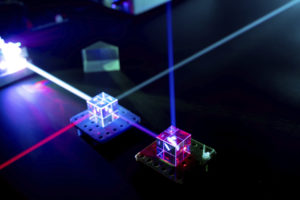Ultrafast analogue spatial light modulator

A spatial light modulator (SLM) is a device used to modulate the amplitude, phase, or polarise light in space and time.
Devices that allow the optical phase to be manipulated in two dimensions have applications in holography, biomedical imaging, laser micromachining, free-space optical communication and beam steering among others.
For many applications, it is desirable to have full analogue control over a full 2π phase range for each pixel. Traditional liquid crystal on silicon (LCOS) devices can deliver multi-level phase modulation, but are only capable of achieving frame rates of around 100 Hz.
Ferroelectric LCOS devices, on the other hand can deliver frame rates in excess of 10 kHz, but are limited to binary phase modulation or show high non-linearity in the response and a steep transition with voltage.
An electro-optic effect that offers both analogue phase modulations with frame rates over above 1 kHz is highly desirable for performance improvements.
Researchers at Oxford have designed a device capable of delivering a multi-level phase shift at response times less than 100 μsec, which has been verified by phase shift interferometry.
The device, due to its remarkable characteristics, enables the next generation of holographic devices to be realised.
Patent protection
A patent has been filed which covers this technology. Oxford University Innovation Ltd. is interested in talking to potential partners to aid in the commercialisation of this new method.
about this technology

